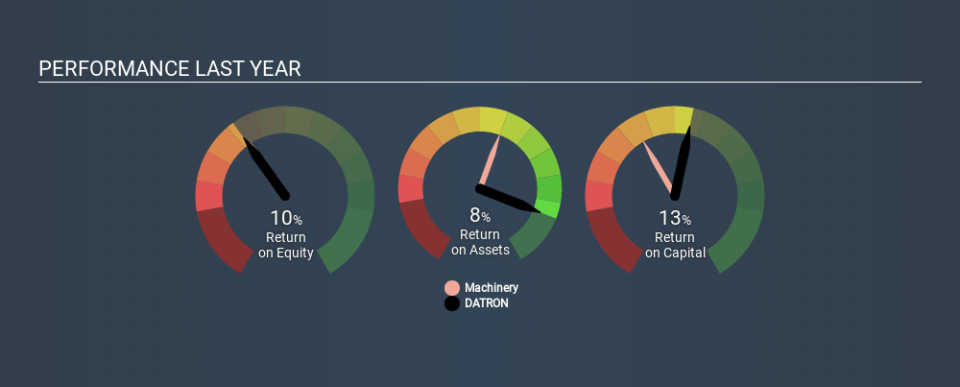What Can We Make Of DATRON AG’s (ETR:DAR) High Return On Capital?

Today we'll look at DATRON AG (ETR:DAR) and reflect on its potential as an investment. Specifically, we'll consider its Return On Capital Employed (ROCE), since that will give us an insight into how efficiently the business can generate profits from the capital it requires.
Firstly, we'll go over how we calculate ROCE. Second, we'll look at its ROCE compared to similar companies. And finally, we'll look at how its current liabilities are impacting its ROCE.
Return On Capital Employed (ROCE): What is it?
ROCE measures the amount of pre-tax profits a company can generate from the capital employed in its business. All else being equal, a better business will have a higher ROCE. Ultimately, it is a useful but imperfect metric. Renowned investment researcher Michael Mauboussin has suggested that a high ROCE can indicate that 'one dollar invested in the company generates value of more than one dollar'.
How Do You Calculate Return On Capital Employed?
Analysts use this formula to calculate return on capital employed:
Return on Capital Employed = Earnings Before Interest and Tax (EBIT) ÷ (Total Assets - Current Liabilities)
Or for DATRON:
0.13 = €4.3m ÷ (€37m - €5.2m) (Based on the trailing twelve months to June 2019.)
Therefore, DATRON has an ROCE of 13%.
Check out our latest analysis for DATRON
Does DATRON Have A Good ROCE?
ROCE is commonly used for comparing the performance of similar businesses. In our analysis, DATRON's ROCE is meaningfully higher than the 9.3% average in the Machinery industry. We would consider this a positive, as it suggests it is using capital more effectively than other similar companies. Independently of how DATRON compares to its industry, its ROCE in absolute terms appears decent, and the company may be worthy of closer investigation.
We can see that, DATRON currently has an ROCE of 13% compared to its ROCE 3 years ago, which was 8.4%. This makes us think about whether the company has been reinvesting shrewdly. You can click on the image below to see (in greater detail) how DATRON's past growth compares to other companies.
Remember that this metric is backwards looking - it shows what has happened in the past, and does not accurately predict the future. Companies in cyclical industries can be difficult to understand using ROCE, as returns typically look high during boom times, and low during busts. ROCE is only a point-in-time measure. You can check if DATRON has cyclical profits by looking at this free graph of past earnings, revenue and cash flow.
Do DATRON's Current Liabilities Skew Its ROCE?
Current liabilities are short term bills and invoices that need to be paid in 12 months or less. Due to the way ROCE is calculated, a high level of current liabilities makes a company look as though it has less capital employed, and thus can (sometimes unfairly) boost the ROCE. To check the impact of this, we calculate if a company has high current liabilities relative to its total assets.
DATRON has total liabilities of €5.2m and total assets of €37m. Therefore its current liabilities are equivalent to approximately 14% of its total assets. A fairly low level of current liabilities is not influencing the ROCE too much.
The Bottom Line On DATRON's ROCE
Overall, DATRON has a decent ROCE and could be worthy of further research. DATRON looks strong on this analysis, but there are plenty of other companies that could be a good opportunity . Here is a free list of companies growing earnings rapidly.
If you like to buy stocks alongside management, then you might just love this free list of companies. (Hint: insiders have been buying them).
If you spot an error that warrants correction, please contact the editor at editorial-team@simplywallst.com. This article by Simply Wall St is general in nature. It does not constitute a recommendation to buy or sell any stock, and does not take account of your objectives, or your financial situation. Simply Wall St has no position in the stocks mentioned.
We aim to bring you long-term focused research analysis driven by fundamental data. Note that our analysis may not factor in the latest price-sensitive company announcements or qualitative material. Thank you for reading.



